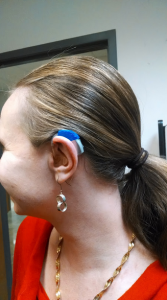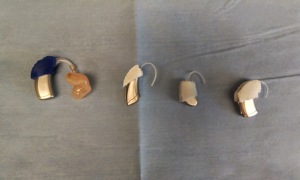If you have ever heard a microphone screech so loud you cringed, then you know what Megan Aanstoos experiences with her hearing aids. Strands of hair brushing against the devices are enough to induce the ear-piercing sound.

“While trying out new aids, I found that the microphone covers were not recessed enough to prevent feedback from hair rubbing on them,” said Aanstoos. “Just like when a speaker at a presentation rubs on the microphone and it makes that grating rubbing sound or a squeal, the hearing aids were doing the same thing.”
The Colorado State University biomedical engineering doctoral student ran into this problem when she was looking into buying a new hearing aid, which cost $5,000. She decided to work on her own solution with the help of CSU’s Idea-2-Product 3D printing laboratory.
The idea
Aanstoos had the idea of developing special covers that would enable the aids to work while also protecting the devices from hair and other potential interferences.
“The covers work to increase that depth between the microphone and the item making the irritation,” said Aanstoos. “So it makes it easier to wear the hearing aid without background noise.”
Idea-2-Product lab partnership
Aanstoos approached David Prawel, director of the I2P lab, about the idea last spring. She had an idea for the covers but needed help designing and printing them. Prawel, in turn, connected her to Craig Egan, who was working in the lab over the summer, assisting students and users with the 3D scanners and printers.
The lab is a public-access 3D scanning and printing facility. Companies, students, faculty, entrepreneurs can pay a fee and make what they want. They can also consult with I2P staff on design work and product development.
Egan was intrigued by Aanstoos’ idea. He too is deaf and immediately understood the problem she was trying to solve.
Together, the two brainstormed about the covers and Egan, who now is earning a master’s degree in architecture, came up with some designs.
“It was really cool to hear that Craig picked up the project up,” said Aanstoos. “And to see the first designs he had made.”
They worked on a few iterations to make the earpiece covers more usable, Aanstoos also gathered input from her audiologist and her patients.
The product

By the end of the summer, Egan and Aanstoos had created a few prototypes for other hearing aid users to test. While Egan is now in Denver pursuing his master’s degree, Aanstoos hopes to gather enough feedback from testers and keep the project going.
Although she ended up purchasing an aid that didn’t need a cover, she wants her 3D printed covers to progress and help others who might need them.
“I wanted to keep the project active so others would be able to buy whatever aids they wanted without worrying about feedback from the microphones,” Aanstoos said.
Having access to the I2P lab and the staff has been key to the project, she said.
“The technology of the Idea-2-Product lab made it possible to take this idea from my brain to an actual product quickly and without the need for a very large grant or industry investment,” Aanstoos said.